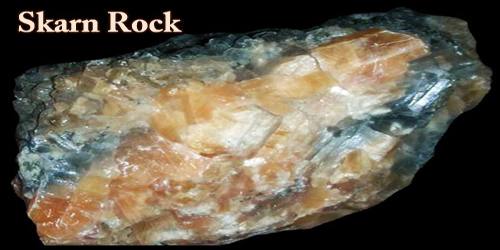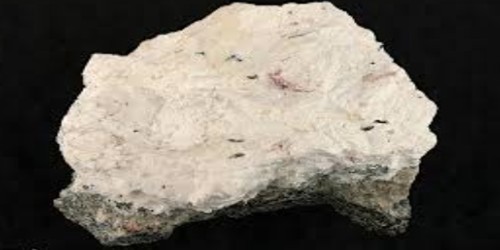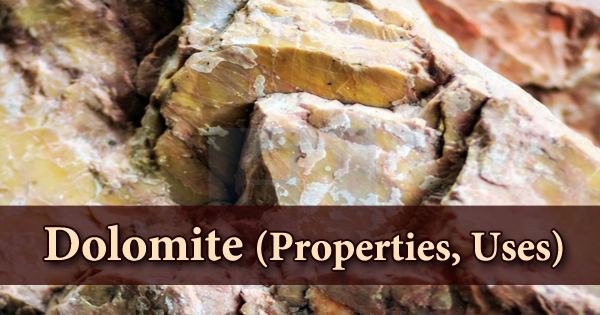Definition –
Skarns or tactites, in geology, metamorphic zone developed in the contact area around igneous rock intrusions when carbonate sedimentary rocks are invaded by large amounts of silicon, aluminum, iron, and magnesium. Skarn tends to be rich in calcium-magnesium-iron-manganese-aluminum silicate minerals that also regerred to calc-silicate minerals. These minerals form as a result of alteration which occurs when hydrothermal fluids interact with a protolith of either igneous or sedimentary origin.
In many cases, skarns are associated with the intrusion of a granitic pluton found in and around faults or shear zones that intrude into a carbonate layer composed of either dolomite or limestone. Skarns can form by regional, or contact metamorphism and therefore form in relatively high-temperature environments. The hydrothermal fluids associated with the metasomatic processes can originate from either magmatic, metamorphic, meteoric, marine, or even a mix of these. The resulting skarn may consist of a variety of different minerals which are highly dependent on the original composition of both the hydrothermal fluid and the original composition of the protolith.
Skarn, in geology, metamorphic zone developed in the contact area around igneous rock intrusions when carbonate sedimentary rocks are invaded by large amounts of silicon, aluminum, iron, and magnesium. Many skarns also include ore minerals; several productive deposits of copper or other base metals have been found in and adjacent to skarns. Granitic and dioritic magmas are most commonly associated with skarns.
Skarn commonly forms around the edges of a magma body that intrudes a nearby rock mass. Rocks formed or altered by the interaction of magma, country rock, reactive fluids, and heat are known as skarn. Other environments of metasomatic activity are also known to produce skarn.
Meaning and Minerals Sources –
Skarn is an old Swedish mining term originally used to describe a type of silicate gangue, or waste rock, associated with iron-ore bearing sulfide deposits apparently replacing Palaeoproterozoic age limestones in Sweden’s Persberg mining district.
Skarns often contain a diverse assemblage of metamorphic minerals. The mineral assemblage in a skarn is determined by the lithology of the invaded rock, the chemistry of the invading liquid, and the temperature of the rock environment.
Metamorphic minerals that characterize the skarn environment include a wide range of calc-silicates, many types of garnet, and a range of pyroxenes and amphiboles. Occasionally, valuable metallic mineral ores occur in skarn. Some of the world’s best copper, gold, lead, molybdenum, tin, tungsten, and zinc deposits have been in skarn.
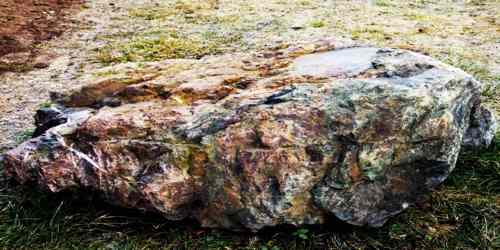
Classifications of Skarn –
Skarns can be divided into sub-sections according to certain criteria:
Skarn can be classified according to its Protolith. If sakarn protolith is sedimentary origin, it can be reffered to as an exoskarn. If the protolith is ignouse rock, it can be called an endoskarn.
Skarn also classification can be made based on the protolith by observing the skarns dominant composition and the resulting alteration assemblage. If the skarn has a Olivine, Serpentine, Phlogopite, magnesium Clinopyroxene, Orthopyroxene, Spinel, Pargasite, and minerals s from the Humite group, are characteristic of a dolomitic protolith and can be classed as a magnesian skarn.
Calcic skarns are replacement products of a limestone protolith with dominant mineral assemblages containing Garnet, Clinopyroxene, and Wollastonite.
Skarn deposits have typical skarn Gangue minerals but also contain ore minerals in abundance which are of economic importance. Skarn deposits are therefore classified by their dominant economic element, such as copper (Cu) skarn deposit, or molybdenum (Mo) skarn deposit to name a few.
Fe (Cu, Ag, Au) skarn deposits –
The tectonic setting for calcic Fe skarns tends to be the oceanic island arcs. The host rocks tend to be gabbros to syenite associated with intruding limestone. The tectonic setting for magnesium Fe skarns tends to be the continental margin. The host rocks tend to be granodiorite to granite associated with intruding dolomite and dolomitic sedimentary rocks. Magnetite is the principal ore in these types of skarn deposits which its grade yields from 40 to 60 %. Chalcopyrite, bornite and pyrite are the minor ores.
Cu (Au, Ag, Mo, W) skarn deposits –
The tectonic setting for Cu deposits tends to be the Andean-type plutons intruding older continental-margin carbonate layers. The host rocks tend to be quartz diorite and granodiorite. Pyrite, chalcopyrite and magnetite are typically found in higher abundances.
Other Skarn Environments –
In the example described above, skarn formed in a carbonate rock unit adjacent to a magma intrusion. There are numerous other geological situations where skarn can be formed. These include skarn associated with seafloor hydrothermal systems; skarn formation along faults and shear zones; skarn forming at depth in areas of regional metamorphism; skarn above subduction zones; and many others. Skarn can form with various water inputs that include: water from magma, shallow groundwater, seawater, or deep brines.
Many skarns also include ore minerals; several productive deposits of copper or other base metals have been found in and adjacent to skarns. Granitic and dioritic magmas are most commonly associated with skarns. Skarns can be zoned, with the inner zones successively replacing the outer ones as the wave of metamorphism moves through the surrounding rocks.
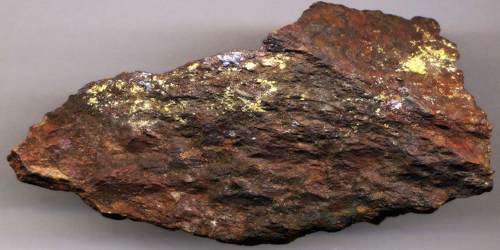
Composition and Formation of Skarn –
Skarn is composed of calcium-iron-magnesium-manganese-aluminum silicate minerals. Skarn deposits are economically important valuable sources, which metals such as tungsten, manganese, gold, copper, zinc, nickel, lead, molybdenum and iron. Skarn minerals are mostly garnets and pyroxene with a wide variety of calc-silicate and associated minerals. Skarn minerals is include pyroxene, garnet, idocrase, wollastonite, actinolite, magnetite or hematite, epidote and scapolite.
Skarns can form on both sides of the boundary between a magma body and its surrounding rock mass. Generally, there are two types of skarns that form, exoskarns and endoskarns.
Exoskarns are more common and form on the outside of an intrusive body that comes into contact with a carbonate unit. They are formed when fluids left over from the crystallisation of the intrusion are ejected from the mass at the waning stages of emplacement. When these fluids come into contact with reactive rocks, usually carbonates such as limestone or dolomite, the fluids react with them, producing alteration (infiltration metasomatism).
Endoskarns form within the intrusive body where fracturing, cooling joints, and stockworks have been produced, which results in a permeable area. The permeable area can incorporate material from the carbonate layer. The magmatic-hydrothermal fluids that were transported or created by the intrusion interact with the carbonate material and form the endoskarn. Endoskarns are considered to be rare. Both the composition and the textures of protolith strongly play a role in the formation of the resulting skarn.
Reaction skarn is formed from isochemical metamorphism occurring on thinly interlayered sedimentary lithology units that involves a small scale (perhaps centimetres) metasomatic transfer of components between adjacent units.
Because skarns are formed from incompatible-element rich, siliceous aqueous fluids a variety of uncommon mineral types are found in the skarn environment, such as: tourmaline, topaz, beryl, corundum, fluorite, apatite, barite, strontianite, tantalite, anglesite, and others.
Gems –
A variety of gemstones have been found in skarn deposits, with garnet, ruby, and sapphire being common occurrences in skarn. Demantoid garnet and topazolite have been mined from the Antetezambato skarns near Ambanja, northern Madagascar. Sapphires are mined from skarn in the Andranondambo Region of Madagascar. Yellow scapolite has been mined from a skarn deposit near the town of Ihosy in southern Madagascar. Rubies have been found in skarn in northern Mozambique.
Information Sources:
